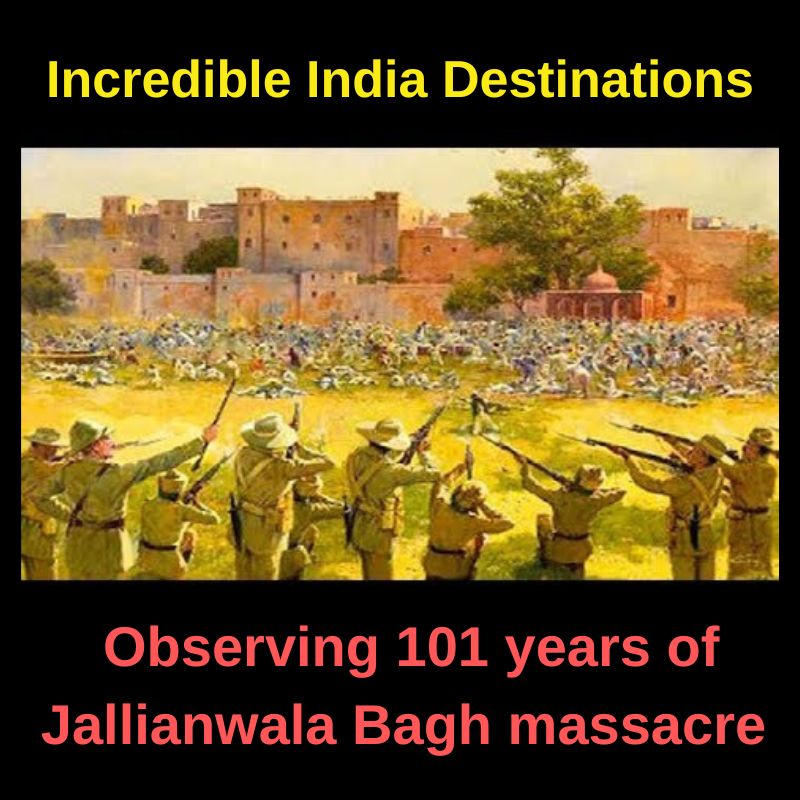Observing 100 years of Jallianwala Bagh massacre
13th April is an auspicious day of Baisakhi celebrated every year, but unfortunately it coincides with the sad anniversary of the Jallianwala Bagh massacre. On the occasion of the 100th anniversary of the unfortunate incident here are some interesting facts that every Indian should know.
1. In the year 1919, the British government passed the ‘Rowlatt Act’, which was basically passed to control the acts of the Indian revolutionaries. The act the government to arrest people without any trial, on terms of mere suspicion. This act sowed the seeds of the upcoming catastrophe.
2. On April 10, 1919, two popular leaders, Dr. Satyapal and Dr. Kichlu were arrested under the act, which made the public furious and fearing a violent repercussion, General Dyer, on behalf of the government issued an order banning any public meetings or gatherings in Amritsar.
3. Two days later on 12th of April, 1919, General Dyer took command of troops. He issued a proclamation banning all public gatherings.
4. Though the proclamation was issued, no efforts were made to ensure that general public came to know about it.
5. Because people had no idea about the proclamation, a public gathering was called at the venue of Jallianwala Bagh. The date was 13th the time for the gathering was 4:30 PM.
Madhya Pradesh Enchanting Destination
6. The gathering had no political intent at all. A public meeting was scheduled for April 13th in Jallianwala Bagh where the festival of Baisakhi was being celebrated and was met with no remorse from the British government.
7. Anywhere between 6,000 and 10,000 people gathered at Jallianwala Bagh on the evening of that day.
8. The gathering included even children and women since it was all about celebrating Baisakhi.
9. Though the festival was a Sikh festival, many Hindus and Muslims also came to celebrate the same. All of them were there for commemorating the day when Khalsa Panth was founded by Guru Gobind Singh.
10. Jallianwala Bagh was an enclosed garden surrounded by walls on every side with just one main gate and two-three tiny lanes for exit, General Dyer took the most voyeuristic advantage of the situation, closed the exit gates and ordered his riflemen to blatantly shoot at the gathering.
Port Blair Tour Package
11. There were a few narrow exit points but they usually remained locked. On that terrible day too, those small exits were locked.
12. General Dyer arrived with a group of 25 Baluchi soldiers and 65 Gurkha soldiers. Two armored cars with mounted machine guns were also brought.
13. General Dyer ordered the soldiers to march inside through the main entrance. He even tried to get the vehicles in. However, the entrance was too narrow for the vehicles were stationed outside.
14. Without sending any warning or without asking the gathered people to disperse, General Dyer ordered the soldiers to open fire.
15. He even asked the soldiers to shoot directly at those portions of the gathering which were most crowded.
Golden Triangle including Khajuraho dance festival
16. Nearly 1,650 rounds were fired. Firing stopped when they ran out of ammunitions.
17. As the firing started, the crowd panicked. They tried to escape from wherever possible. This led to stampede, killing several people.
18. There was a well in Jallianwala Bagh. People even jumped into it in order to escape bullets and ended up dying in the well. Of course the bullets killed far too many than stampede and drowning in well. It is said that 120 dead bodies were pulled out of the well.
19. Twisted official reports were released by British Raj which stated that 379 were killed and 1,100 wounded.
20. Williams DeeMeddy indicated that 1,526 people were killed. According to Indian National Congress, over 1500 people were killed that evening.
Same Day Taj Mahal Tour Package
21. The news of the massacre reached Britain in December, 1919 when Hunter Committee was formed for inquiry. Before the Hunter Committee started its proceedings, the British governments pass Indemnity Act in order to safeguard its officers. As expected, General Dyer walked clean except that he was called back to England after resigning.
22. Due to no fruitful follow up, the Indian National Congress appointed its own trusted officials to enquire about the incident, which included Motilal Nehru and C.R Das.
23. The Jallianwala Bagh Massacre led Rabindranath Tagore to renounce his Knighthood. Mahatma Gandhi returned Kaisar-i-Hind medal that he received because of his work during Boer War.
24. Among those who managed to escape was 21-year-old Udham Singh, an orphan raised at Putlighar in the holy city. Twenty-one years later, on March 13, 1940, Udham, who had close association with Bhagat Singh’s Hindustan Socialist Republican Association, shot Michael O’ Dwyer at Caxton Hall in London. He finally redeemed the vow he had taken on April 13, 1919: to avenge the massacre. Carnage he never forgot or forgave.
25. It is widely believed that there would have been no Jallianwala Bagh massacre had it not been for one man, who decided to teach Indians a lesson for being “wicked”. Ninety-one years after his death, Col Reginald Edward Harry Dyer, also called the butcher of Amritsar, remains an enigma, painted in either black or white.
Pink City Jaipur Tour Package
26. Few know that Dyer was born and raised in Punjab, or that he was as well-versed in Hindustani as in English or that one of his favorite possessions was the photograph of an unnamed Sikh officer. What is well-documented is his action at the Jallianwala Bagh, which proved to be as much his undoing as that of the British Empire in India. Held guilty by the Hunter Commission, the mustachioed officer was forced to resign and sent home.
25. The Indian National Congress built a memorial for the innocent souls who departed on the unfortunate day and the memorial was inaugurated by Rajendra Prasad in 1961.
Old – New Delhi Tour Package
Dyer became a hero back home
26. Though reviled by the Hunt Commission, Viceroy Chelmsford and the House of Commons, Dyer received a hero’s welcome from the House of Lords and many well-known Britons, including author Rudyard Kipling, in 1920. The Morning Post even started a fundraising drive, which was supported by many British Indian newspapers, including Calcutta Statesman, Rangoon Times and Press, and Madras Mail. Together they raised a princely £28,000.
27. Amid worsening health, Dyer penned “Raiders of the Sarhad”, an account of his campaign in Persia. Soon he was diagnosed with “arteriosclerosis”. After suffering a series of strokes that prompted the couple to retreat to a quiet cottage in Southampton, Dyer died of cerebral hemorrhage in 1927. On his deathbed, he reportedly said: “So many people who knew the condition of Amritsar say I did right… but so many others say I did wrong. I only want to die and know from my Maker whether I did right or wrong.”
28. Nigel Collett, the author of “The Butcher of Amritsar: General Reginald Dyer”, says: “What persuaded me that Dyer wasn’t a bloodthirsty bully was the fact that he went to his grave worrying about whether he was right or wrong.”
North India Tour Package
Opinion by Dyer’s colleagues
30. On April 13, 1919, Dyer, 55, was like a man possessed. Giving a first-hand account of the day in “Amritsar: The massacre that ended the Raj” by Alfred Draper, Dyer’s bodyguard Sergeant William Anderson recounted how the crowd seemed to “sink to the ground in a flurry of white garments” as the first volley was fired. The kneeling soldiers selected their targets and made each round tell. When the soldiers had emptied their carbines, Dyer ordered them to reload and direct their fire where the crowd was the densest.
31. Anderson says he noticed Dyer’s brigade-major Captain Briggs crunching his face as if in pain and clutching at Dyer’s sleeve, but the latter did not notice, and instead directed fire towards the pipal trees where a large number of people were concentrated.
32. Later, when deposing in front of the eight-member Hunter Commission, he told Chimanlal Setalvad, vice-chancellor of Bombay University: “I did not like the idea of doing it… it was a merciful though horrible act… I thought I would be doing a jolly lot of good and they would realize that they were not to be wicked.”
33. Later, after his resignation, Dyer told a reporter: “And now, I am told to go for doing my duty — my horrible, dirty duty.”
Rajasthan Tour Package
Here are some lesser known facts about the great martyr Udham Singh
34. Udham Singh was born as Sher Singh in Sangrur, Punjab.
35. He became an orphan at an early age and was taken away by Central Khalsa Orphanage, Putlighar. He was named Udham Singh after he joined the orphanage.
Agra Mathura Tour Package
36. Udham Singh was an eyewitness of the Jallianwala Bagh massacre.
37. Udham Singh was a fond of Bhagat Singh and used to look up to him as one of his idols.
38. Shaken with incident, he had one overpowering obsession: to kill O’ Dwyer.
39. He joined other Indian revolutionaries and visited many countries, the ultimate destination being London. He used several aliases, including Sher Singh, Udhan Singh and Ram Mohammed Singh Azad.
40. In 1933 Udham Singh managed to flee to Europe. After passing several countries he reached London in 1934. He stayed in a house in East London and joined a socialist organization that worked for the cause of Indian workers.
South India Buddhist Tour Package
41. On 13 March 1940, Udham Singh hid his revolver in a book and assassinated Dwyer during a meeting at Caxton Hall, London. He had carved the shape of the revolver to fit it inside the book.
42. Udham Singh did not run away after shooting two times at Dwyer, who died on the spot. Singh, instead, waited for the officials to arrest him.
43. While awaiting his trial, Udham Singh went on a 42-day hunger strike and had to be forcibly fed. He was hanged at Pentonville Prison in July 1940. Jallianwala Bagh massacre
44. His weapon, a knife, a diary and a bullet from shooting are kept in Black Museum, Scotland Yard.
45. The remains of Udham Singh are preserved at Amritsar’s Jallianwala Bagh.
46. Udham Singh was given the title of Shaheed-i-Azam (the great martyr).
Kerala Backwater Tour Package
UK’s regret
47. In February 2013, then Prime Minister of UK David Cameron had visited the Jallianwala Bagh memorial at Amritsar and expressed regret at the incident. He had, however, stopped short of tendering an apology.
48. Cameron wrote in the visitor’s book: “This was a deeply shameful act in British history, one that Winston Churchill rightly described at that time as ‘monstrous.’ We must never forget what happened here and we must ensure that the UK stands up for the right of peaceful protests.”
49. Although nothing can be undone to change the catastrophe, but it is essential that the light of respect and gratitude for all the people who fought and lost their lives for Mother India, should always burn bright in the hearts of every Indian.
Was it possible for Gandhi to save Bhagat Singh?





[…] Observing 100 years of Jallianwala Bagh massacre […]
[…] Observing 100 years of Jallianwala Bagh massacre […]
[…] Observing 100 years of Jallianwala Bagh massacre […]